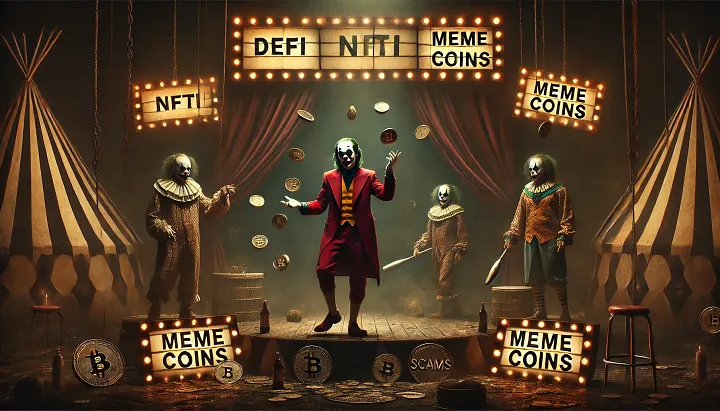and the distribution of digital products.
DM Television
Can Cryptocurrency Enable a Stateless, Global Economy?
When Bitcoin was released to the world in 2008 it was celebrated as a pivotal moment in technology and cryptography. It opened our eyes to the possibility of a path forward for society in terms of a global financial system free from the incumbent systems, liberating money from the clutches of the state by offering a transparent, permissionless alternative. Like many early adopters I was swept up in the excitement. The vision of a world with a fair and global peer-to-peer economy excited me as I imagined the power this would unlock for both individuals and organizations without influence by state actors who are more and more disconnected from the plight of their own communities. Today the path we’ve chosen has taken a sharp turn away from the original vision and values from which it spawned.
\ Personally, I am very proud to be working in the crypto industry. I consider myself an evangelist for a technology that embodies the very ideals of liberty upon which the United States was founded, inspiring the world with our inalienable rights enshrined in our constitution and declaration of independence. However, I fight an uphill battle on a landscape littered with false promises, innumerable scams, and half-baked use cases that leave myself, and frankly a lot of people, disillusioned and embarrassed.
Bitcoin as an Inspiring VisionThe first of us who embraced Bitcoin saw a radical departure from the status quo. The promise of the first truly decentralized currency was revolutionary. A money free from state influence, inflation, and pressures of speculation had the potential to reshape the world. A truly global peer-to-peer economy could unlock value that went unmeasured, eliminate the bloat of a middleman economy and create a more competitive environment for innovation around the world. This innovation was positioning itself to be more profound than the printing press, the internet, or perhaps even the written word. \n
The critical innovation that allowed this vision to capture our hearts and minds was decentralization. The idea that no single individual or organization would control the currency was far more than a technical achievement, it was a philosophical and ideological stance against centralization of economic power. Decentralization would distribute economic power into the hands of individuals around the globe, releasing them from the whims of corrupt states, institutions, or towers of global finance. The underlying technology, blockchain, with its immutable and transparent ledger was positioning itself to transform much more than finance alone by offering a censorship resistant platform for the exchange of value instantly around the world without the need for intermediaries or 3rd party validators.
A Deterministic MoneyWhat made Bitcoin and other crypto currencies unique compared to fiat money was its deterministic monetary policy. Unlike fiat, where central banks control the printing at will effectively inflating the value and introducing a hidden tax on individuals, crypto currencies like Bitcoin offered a fixed supply and were immune to this type of inflation. This caused many who looked into crypto currencies to re-evaluate the nature of value and the power of their fiat. By tying the creation of money to physical work, or the expenditure of energy, it introduced a digital money relatable to gold yet incredibly more versatile.
\ With the versatility of digital currencies, and a utility relatable to gold, the innovation promised to eliminate the plague of fiat in traditional finance where speculative bubbles and complex financial instruments often disconnect the prices of goods from their real-world economic value. Crypto currencies, in contrast, provided a more accurate reflection of economic fundamentals. Believing this to be true, advocates for crypto currencies promised to democratize finance and provide a solution that would shift the power away from centralized institutions, redistributing it back to individuals.
\ Separating the link between states and money, crypto currencies had the potential to redefine the role of government in our lives. When the state could influence economies through control of the money they effectively had obtained a form of unchecked power. Instead, a decentralized financial system would usher in a more balanced dynamic where the state played the role of just one stakeholder among many instead of the dominant force.
Ideals Were AbandonedThe vision and ideals that invigorated us in the beginning unfortunately have been compromised and disillusionment is growing. Building a decentralized, scalable system is an incredibly difficult and complex task. To be successful, builders require a deep understanding of game theory, information science, mathematics, and the physics of computer networks. Many projects opted instead for expedience over stability, launching quickly while attempting to fix issues on the fly. This has led us to a world proliferated with blockchains, while operational, fall short of our original vision and the ideals we began with are increasingly difficult to find today.
\ The biggest compromise we’ve made is the shift away from Proof of Work (PoW) consensus in our decentralized systems to Proof of Stake (PoS) and other consensus mechanisms that significantly reduce decentralization, while only incrementally improving scalability. While these blockchains may be faster, they’ve become little more than digital casinos and are effectively centralized while they masquerade as decentralized. Solana, as an example, with its small number of validators demonstrates how the pursuit of scale has all but eroded the original values of the crypto currency community.
\ In a rush to market, many blockchains began to adopt poorer and poorer architectures that end up depending on additional layers being built on top of them in order to maintain a modicum of value. Layer 2 and Layer 3 blockchains built on top of weaker Layer 1 blockchains have fragmented the user base and liquidity further undermining the goal of decentralization. What has resulted is a landscape littered with isolated projects that are fundamentally flawed, offering a facade of innovation while failing to deliver on the promise of a truly decentralized, scalable, and secure financial system.
Crypto Currencies Are LostAs truly decentralized blockchains struggle to handle increasing demand and speed up for wider adoption, even promising applications that are needed for continued adoption are stifled either by the inability to scale or the fragmentation of users. The inability to scale causes transaction fees to rise when demand increases which results in abandonment by its users and use cases that require a guarantee of execution at a fixed price. This bottleneck has limited adoption of decentralized blockchains as a financial system over and over again. \n
Adding to the confusion of building a scalable, decentralized system, the space of crypto currencies has become plagued by an overwhelming number of projects. Most of these projects range from misguided to outright scams. DePIN (Decentralized Physical Infrastructure Networks) and specialized blockchains like Filecoin for for filestorage or the proliferation of of JPEG NFTs (Non-Fungible Tokens) with no actual conveyance of rights represent many projects that are merely attempts to cash in on the crypto boom. These projects often lack long-term sustainability or meaningful value and are driven by the allure of quick profits rather than real innovation.
\ As the industry evolves, each new cycle brings increasingly predatory projects and venture capital. The rise and fall of ICOs (Initial Coin Offerings) in 2017, a summer of DeFi (Decentralized Finance) in 2020, the NFT craze of 2021, a collapse of clearly flawed stablecoins in 2022, and now the nihilistic capitalist nature of meme coins where people gamble on literal ponzi schemes like “Black Coq Inu” enabled by other vampire projects like “Pump.fun” run amok. Even venture capitalists, who have been in the industry since the beginning, are beginning to wonder if we’ve given up on the ideals that started this industry. The industry itself seems to have run out of creative and meaningful ideas, resorting to pitching even more absurd concepts built on fundamentally flawed systems.
The Path ForwardTo advance our industry and fulfill its original promise some self-reflection is absolutely necessary. We need to prioritize addressing the hard and fundamental challenges that have bottlenecked wider adoption; mainly scalability, privacy, and a truly crypto-native stable token. These challenges are more than just technical; they are foundational to the very concept of crypto currency as a revolutionary technology for global transformation.
\ If we can’t build money as a decentralized, scalable, and stable digital currency then we can’t build any real applications on top of it. Money is the bedrock of any economy and in the context of blockchain it must be efficient and secure. If we can’t solve scalability in our blockchains without sacrificing decentralization then all applications built on top of it will be fragile at best and unsustainable at worst.
\ Privacy is just as critical. As crypto currencies become more widely adopted the need for secure, private transactions will become increasingly important to the individual using it. A lack of privacy allows for mass surveillance and an erosion of individual freedoms. An end state without privacy also contradicts the very ethos of a stateless financial system enabled by decentralization and cryptography.
\ Lastly, we need to build native stable tokens as a unit of account in order to divorce ourselves from fiat. While various stablecoins exist, most are simply pegged to fiat currencies and rely on centralized entities and institutions to exist and remain stable. A truly crypto-native stable token, issued on a decentralized blockchain, would provide a unit of account for everyday transactions without relying on external, centrally governed fiat currencies. This is critical for a global peer-to-peer economy and a medium of exchange within the crypto currency ecosystem.
\ This isn’t an easy path, but it's necessary that we stay dedicated and focused to progressing down it. By focusing on the fundamental challenges the industry can begin to move away from the distractions of the short term hype and speculative bubbles of scams and predatory projects and back towards a truly decentralized, stateless financial system. Only by addressing these challenges head on can we hope to achieve the vision of a revolutionary technology that transforms the world.
\ If you would like to learn more about how to address these problems in challenges follow me on twitter: @mechanikalk or @quainetwork #quai
- Home
- About Us
- Write For Us / Submit Content
- Advertising And Affiliates
- Feeds And Syndication
- Contact Us
- Login
- Privacy
All Rights Reserved. Copyright , Central Coast Communications, Inc.



